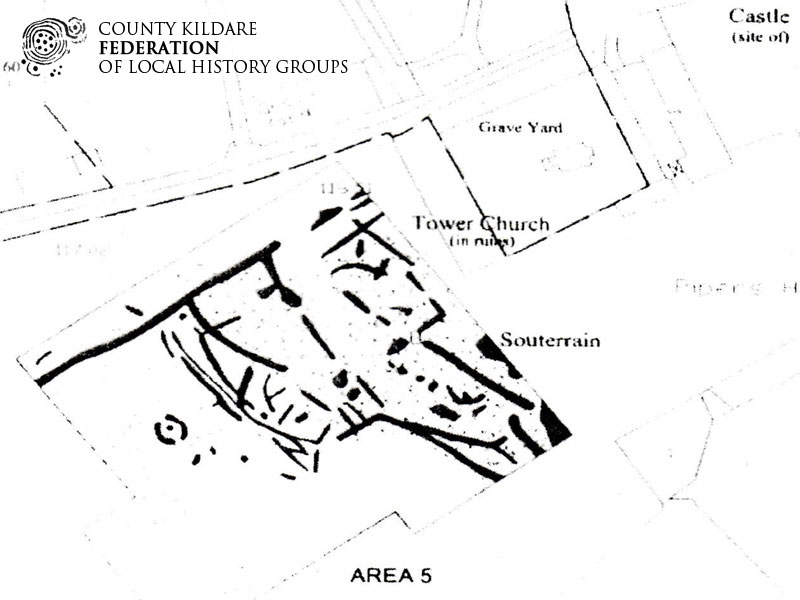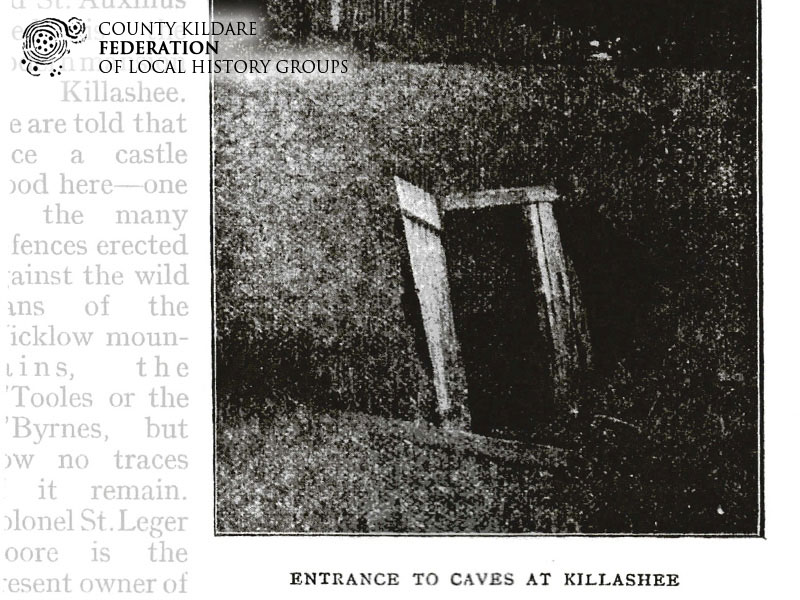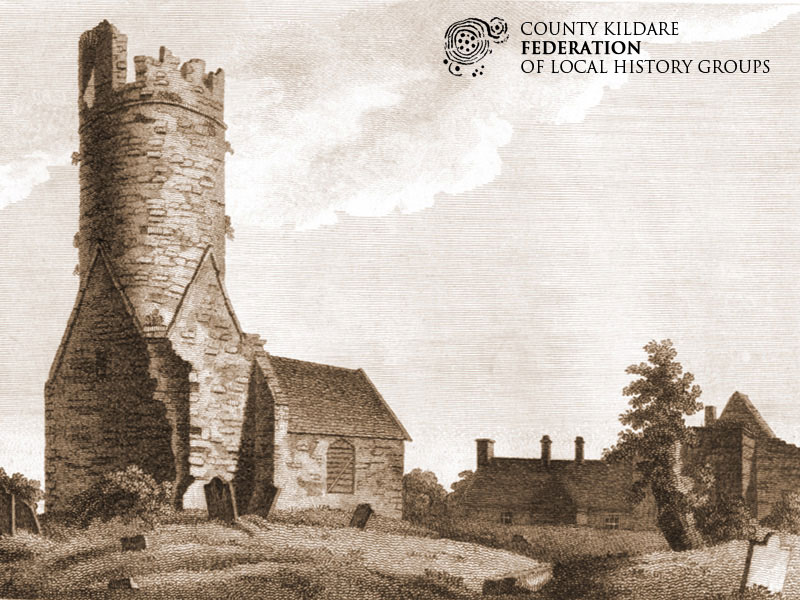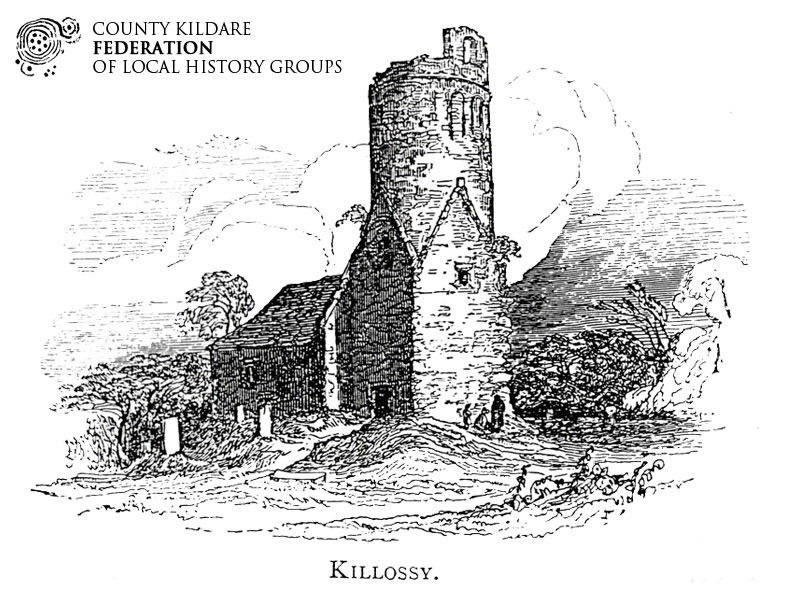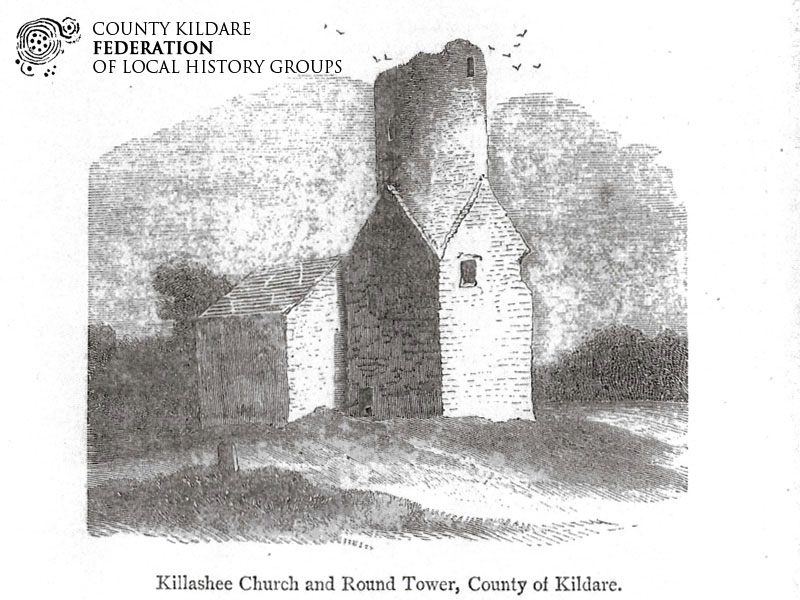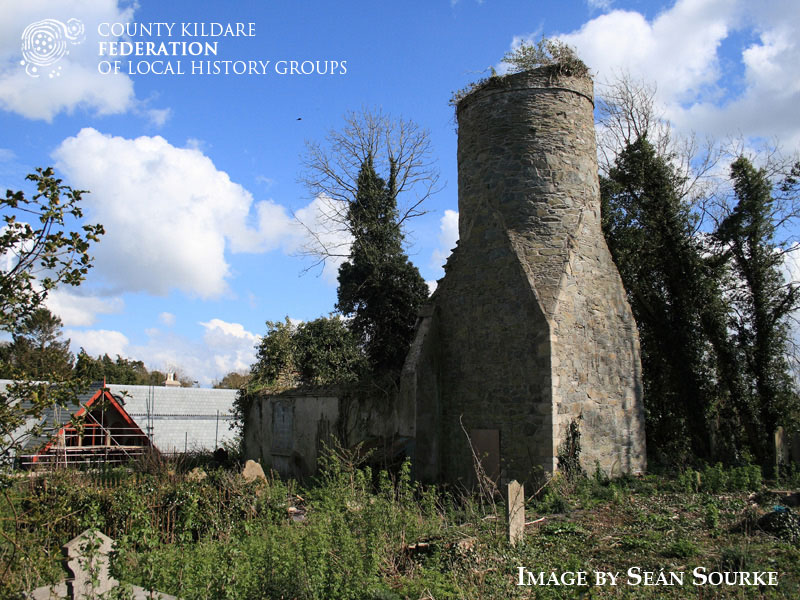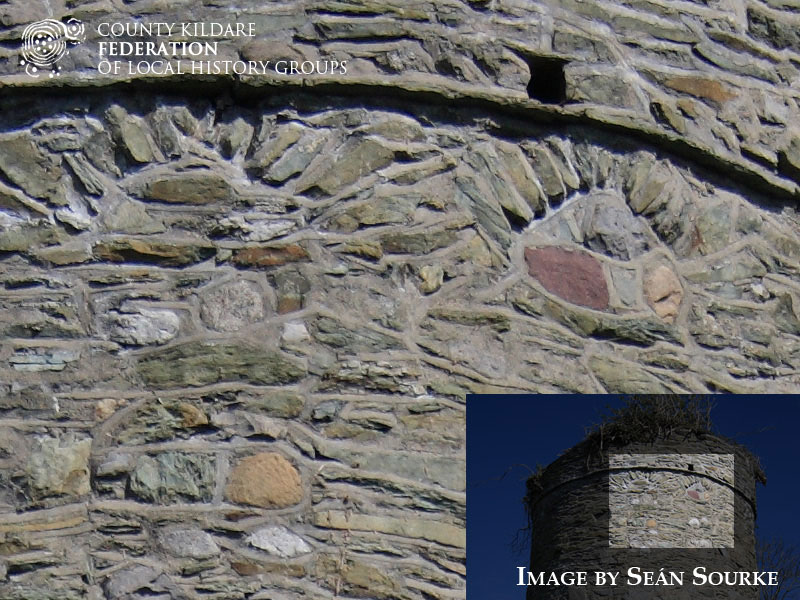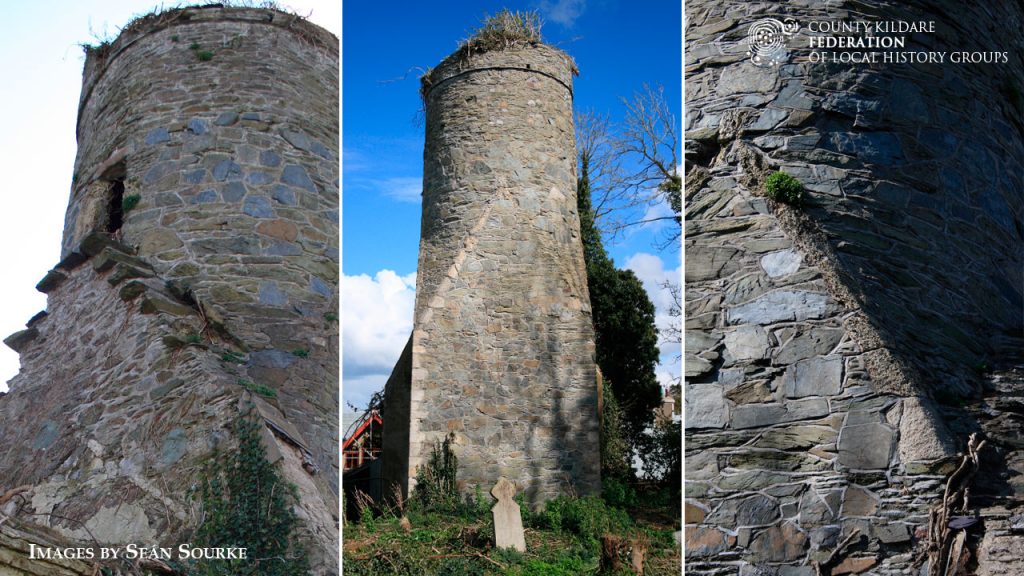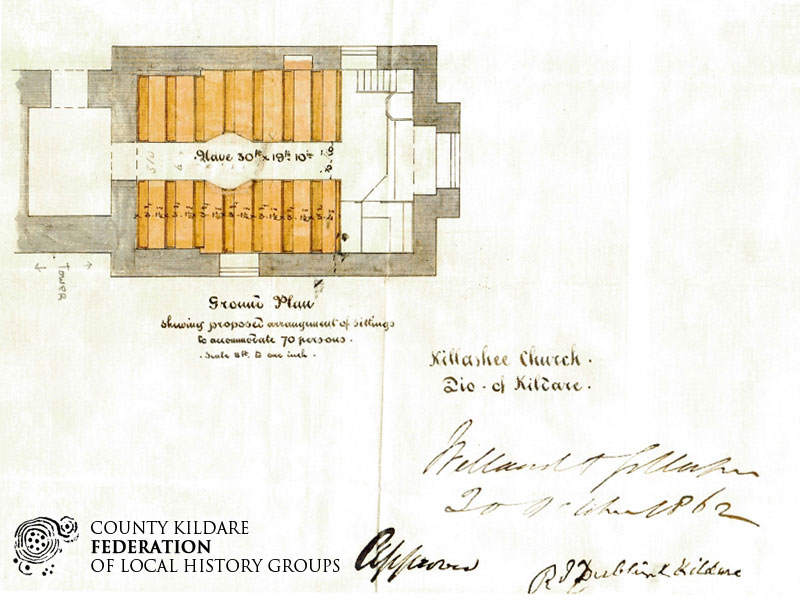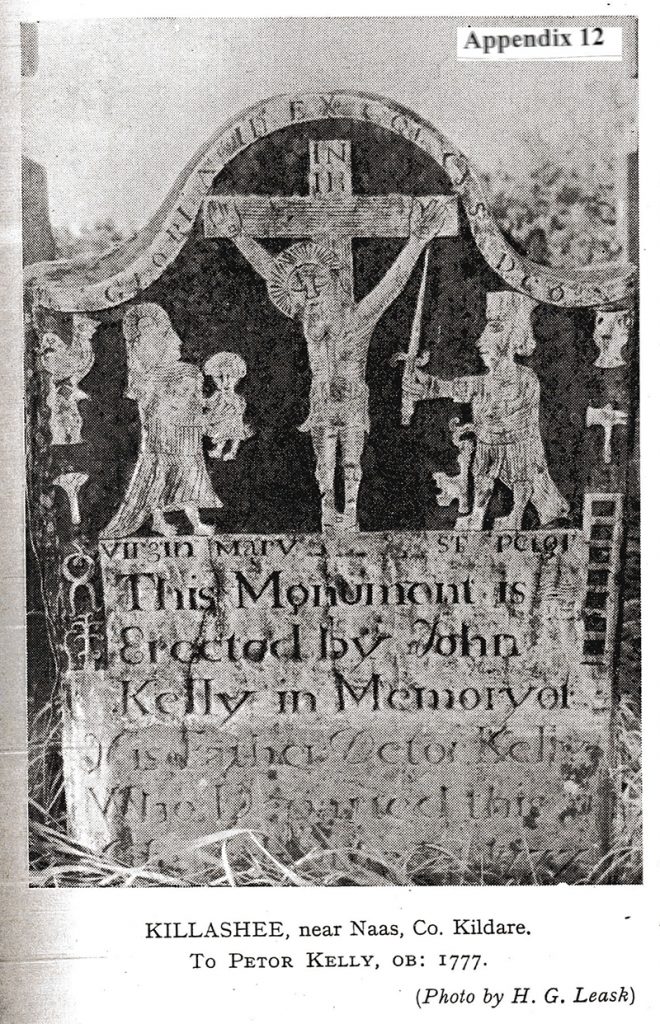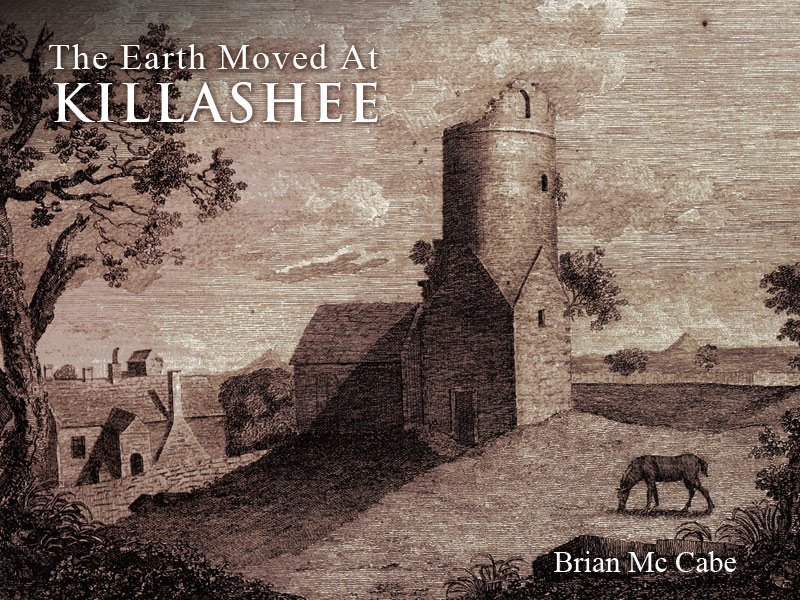The Earth Moved at Killashee
An examination of the history and archaeology of the ancient ecclesiastical foundation at Killashee, Naas, Co Kildare, and a survey of its modern graveyard.
By Brian Mc Cabe
(Kill History Group)
The large scale movement of earth in recent years, ahead of planned development work, at the ancient ecclesiastical site at Killashee near Naas, Co Kildare, has had the not- unexpected affect of uncovering some interesting archaeological features. Apart from the discovery of some bones at the commencement of ground clearance, the most intriguing outcome has been the (re) discovery of the long lost Killashee “caves”. It also provides an opportunity to look again at the history and archaeology of this old and interesting foundation.
Overview of History
In fact, the very first volume of the Kildare Archaeological Society’s Journal dealt with the site and the early ecclesiastical ‘saint’ (Auxilius) who is usually associated with it. This article, citing the various lives of St Patrick, describes Auxilius as a nephew of his, and goes on to quote later accounts of his having assigned the “church” at Killashee (Cell Auxilli) to him.1 This is also the account given by Comerford in his history of the Diocese of Kildare and Leighlin. 2
More recent scholarship however has concluded that Patrick was not the only – nor indeed the earliest – evangelist in 5th century Ireland. For example, the recently published “Kildare: History & Society” concludes that, although later sources associate Auxilius and Isserninus with Patrick, they are more likely to have been companions of Palladius, the first bishop despatched by Pope Celestine as primus episcopus, ad Scotus in Christem (first bishop to the Irish believers in Christ). 3 This would also explain the passage quoted from the ‘Chronicon Scotorum’ in Fr Murphy’s article which puzzled him so much [“Secundinus, Auxilius and Isserninus are sent to the Irish, but they obtained not pre-eminence or authority in the time of Patrick alone”].
Another chapter in the ‘History & Society’ publication deals with the cults of Brigid, Patrick and the Kings of Kildare 640-850 AD. This deals with the geographical areas of jurisdiction claimed by the respective church authorities at this time and identifies the church at Killashee with the Ui Bairche dynasty, whose allegiance was claimed by the Patricians in Armagh, rather than the followers of Brigid in Kildare. The author concludes that, given the evidence for Ui Bairche churches which supported Patrick in the east of and south of Kildare, it is possible that this is a precise reflection of (factional) political realities in the later seventh century. 4 In any event it would seem to hint at a different – and possible earlier – origin for the Killashee foundation. By the early ninth century, an Ui Dunlainge power block had conquered some of the northern reaches of Ui Bairrche land, details of which are given in Bethu Phatraic, an early tenth century compilation. 5
The importance of the foundation can be judged from the recording, in the Annals of the Four Masters, of the death in A.D.827 of ‘Maeldobharchon, Abbot of Cill Uasaille’ and, in 870, of ‘Loingseach, son of Faeillen, Abbot of Cill Ausaille’. A later reference, in the same annals record a raid on the site in 1035: ‘Cill Usaille and Claenadh (Clane) were plundered by the foreigners; but the sons of Donnchadh, son of Domhnall, overtook them and made a bloody slaughter of them’.
Moving from its early foundation and fragmentary record, one is on surer ground in later centuries. For example, there is a definite reference in Archbishop Alen’s Register (13 May 1179) to the taking into possession by Pope Alexander III of the diocese of Glendalacen (Glendalough) and the confirmation of its possessions to Bishop Malchus at his request, viz. the ‘city’ of Glendalough with its churches including … Cell Usaille.6 The register also contains a reference to a ‘William le Taylor de Killacy’ in an extent of January 1326. 7
Light is also shed, in the Register of the Abbey of St Thomas, on a 13th century payment dispute between the canons of the Abbey and one David of Killashee (‘personam de Kilussy’). The full text of the entry is set out in the Appendix 1. 8
Another early reference can be found in the ‘Ecclesiastical Taxation of Ireland 1302-6’ where, under “Le Nas”, the churches listed include ‘Kyllassy’. No value was given but, at this stage, the [Knights] Hospitallers are cited as ‘ Rectors’.
Another source for some early medieval references is the Calendar of the Gormanstown Register* which is primarily an entry book of the title deeds of the estates of the Prestons, lords of Gormanstown, and which cover a period from circa 1175 to 1397. For example, the very first entry lists a calendar of free tenants, by Royal Service in the county Kildare, of William Lowndrys, which includes (under ‘Reversions after children’) ‘Kyllussy’ which is listed as being worth 8 pounds. 9
In 1307 we find a record of a covenant made between William de London and Thomas, prior of the house of St John of the Naas, and brothers, whereby William had granted “and let to farm…the mill of Killussi, for the term of 20 years…with all liberties customs and easements belonging, as in bringing and retaining water, making weirs, and license to repair the mill from William’s wood there…rendering yearly two marks of silver at the feasts of All Saints and of SS. Philip and James, for all secular exactions”. 10
In 1318 there is a charter of Walter de Isclep, clerk, whereas William de London, knight, is bound to him in 160 pound sterling, which he had received as a loan and in respect of which he had granted to Walter “one carucate and 80 acres of land in Killussilt…(together with other lands in and around Naas)…. To hold, at the valuation of 20 pounds yearly, for the term of eight years from the making of these presents, until the said debt be satisfied…with the issues of the courts of Killussilt and Surdevaleston. 11
In 1323 we get a fairly detailed account of conditions at Killashee. An agreement is recorded between master Walter de Istilip, clerk, and John Shynnagh that Walter granted to John “one carucate and 80 acres of land in the town of Killussy in the barony of the Naas..to hold for six years, rendering to Walter £15 yearly, half at All Saints and half at feast of SS. Philip and James. Provided that wards, escheats, marriages and reliefs, which may happen by reason of the free tenants of the lordship of said town of Kyllussy, remain to Walter. He has granted also that John may hold his courts there, but that he answer to Walter of the issues of the courts yearly. John will not remove without assent of Walter any tenant farmer of the town, as long as they may be sufficient to pay and do the rent and services, which rent and services John shall receive.” 12
In 1329 there is an agreement between Walter de Istelep and John, son of Philip Schynnagh, that “Walter has given to farm to John one messuage and ten score acres of arable land, meadow and pasture in Killussy…to hold for the term of 8 years beginning on the feast of St Michael in said year..rendering yearly for each acre 16d at the feast of SS. Philip and James. If the rent remain unpaid for more than a quarter of a year, and that sufficient distraint of the cattle of John, his heirs and assigns, cannot be found on the lands, then Walter and his assigns may enter the lands and retain the crop growing there.” 13
A decade later, in 1339, it would appear that the aforesaid William de London had died and been succeeded by his son (also called William) to whom a John de Grauntsete quits claim
“all his right in the manors of the Naas, Kullussy…..which have come to William by hereditary succession of his purparty of the barony of the Naas and all action or demand which he may have against him. Saving to John, for term of his life, the fees and pensions as well of clothing as money, granted to him by Sir William and William the son”. 14
There is little record of the holdings over the next few centuries but by the time of the Dissolution of the Monasteries [1539-40] the rectory of ‘Kyllusty’ is shown as a holding of the [Knights ] Hospitallers of Kilmainham. 15 The tithes were 11 ‘couples’ of grain (£7 6s 8d ) and the rectory was held from the priory for a term of years by Sir Thomas Lutterell for £6 10s. The vicar received the rest of the tithes and the advowson was the king’s.
There are also a number of references, from around this period, to be found in the Calendar of Inquisitions. For example, a list dated 23 May 1538, before the Barons of the Exchequer, of Irishmen presented to beneficies by Walter [Wellesley], bishop of Kildare, included John Lanan, vicar of ‘Kyllusse’ (worth £9 p.a). 16 A list of ‘absentee’ clergy of 12 November 1556 included Walter …(unfortunately the surname is missing), vicar of Kyllussy. The record goes on to note that ‘the same clergy do not keep schools in which to teach English as required by the act of 28 Henry VIII’. 17
On 16 Feb. 1561 Janico Preston, with others, granted to Patrick Sarsfield of Dublin, merchant, the manor of Whitechurch and other lands including Kyllussy, which he had by inheritance as Viscount Gormanston, for 61 years from the ensuing Easter at £38-3-11 per annum for the first 21 years, plus 6 pairs of cart wheels and 15 couple of fowls at Christmas and £41 -3-11 and 15 couple of fowls for the remainder of the term. 18
One Edmund Goldinge of ‘Harbartestone’ (presumably Herbertstown) died on 12 August 1584 with a number of holdings including ‘7 gardens in Dowdingestone and 2s per annum out of ‘Killussie, held of the queen by service unknown’. 19
A Richard Belinge of Killussey is mentioned in a land grant of Dec. 1586 and a Walter Bealinge in 1591. On 6 June 1591 Sir Thomas Fitzwilliam of ‘Mereynge’ Co Dublin granted all of ‘Bassardstowne’ excepting (name missing) to William Bermingham & Walter Bealinge of Kilussy, gent.20 There is also a record of a grant in Feb 1596 of land in Pilletston Co Dublin to John Kerdyf of Donsinck & Christopher Belinge of Killussie. 21
We also get some glimpses of the rectory of Killashee, during this period, in the Fiants of Elizabeth Tudor. For example, in April1578, there is a record of a Commission to Sir John Garvie, Dean of the Holy Trinity, Dublin, Ambrose Forth of Dublin gent and Nicholas Eyllmer [Aylmer] and others, as delegates, to hear an appeal from a sentence of George Ackworth LL.D, against William Fitzgerrald, vicar of Kyllussye, diocese of Kildare, concerning the vicarage. 22
In 1585 there is a record of a Lease (under Queen’s letter dated 24 October) to Thomas Renwick, Soldier, of the rectory of Killussy, Co Kildare (reciting an earlier lease to Sir Thomas Lutterell of 9th July xxxi Henry VIII) and other holdings to hold for 30 years from the determination of the recited interests, at a Rent of £10 11s 6d, on condition that he “shall not alien except to persons of English nation and blood or born in the Pale and shall not charge coyne or livery”. 23
The Civil Survey [1654-56] 24 lists a number of land holdings in the Parish of ‘Killishae’.
Richard Bealing (described as an “Irish Papist”) held 140 acres in Killishae worth £21. There was, at the time, one castle and one mill on the land [This, according to the Book of Survey and Distribution, was disposed of to Sir Maurice Eustace]. Christopher Eustace of Newland (Irish Papist) held 284 acres in Phlemingstown worth £20, 206 acres in Steeventowne (with a poll in Balligurtan) worth £40[both transferred to Sir Maurice Eustace], 320 acres in Newland worth £55 [transferred to the Duke of York] and 34 acres in Milettstowne worth £10 [transferred to John Lattin]. George Fitzgerald, the then Earl of Kildare (Protestant) also had land in Millettstowne (60 acres) worth £15. John Lattin of Morristowne (Irish Papist) had 330 acres in Millettstowne worth £10. Rowland Eustace of Mullacash (Irish Papist) held 180 acres in Mullacash [transferred to Maurice Fitzgerald] and Ouldtowne [transferred to Duke of York] worth £30 and £6 12 s respectively. He also had 80 acres in Newtowne worth £12 [also transferred to Duke of York].
The impropriacon of the Parish is cited as belonging, in 1640, to Simon Luttrell of Luttrelstown and the ‘thirds’ were then possessed by Nicholas Stafford, then Vicar.
The whole tithes were worth £120 in that year.
The ‘Census’ of 1659 25 shows ‘Killishay’ with 26 ‘Irish’ and no ‘English’ inhabitants.
By the eighteenth century, the lands at Killashee had passed to a family called Graydon, who were to be associated with the area for the next hundred years or so, and whose memory is dimly recalled in the name “Graydon’s Folly” which is applied, by older residents, to the old abandoned mill – the ruins of which still stand near the church.
When the antiquarian Grose visited the area in 1792 he recorded that “There is a castle and house at Kilussy; the latter the seat of Robert Graydon, Esq. The castle is a square battlemented tower of great strength, and is fitted up and used as offices for servants.” 26
By the time of the first Ordnance Survey [November 1837], 27 the name of the area is recorded as “Cill Uisigh” which was then believed to signify the ‘Burial Place of Oisin’. None of the old church then remained but it was recorded that there was a round tower having a square base attached to the west end of the ‘modern’ church which was “very small”. They also reported that “ a few years ago an old castle stood near the Round Tower “ but that it had been thrown down and that “the stones of it are yet to be seen”.
By the middle of the nineteenth century the lands were owned by the Moore family who abandoned the old house and built a massive Victorian mansion, in the Jacobean style, nearby. The Moores sold the estate in 1927 to a French order of nuns [La Sante Union] and the estate was divided up shortly after that.
REFERENCES
1 Rev Denis Murphy; “Killashee Church”; Journal of County Kildare Archaeological Society, Vol 1 pp13-18 Back
2 Rev M.Comerford; “Collections relating to the Dioceses of Kildare and Leighlin” (Dublin & London, 1886) pp 294-5 Back
3 Nolan & Mc Grath; “Kildare: History & Society”; (Dublin, 2006) p.153 Back
4 Ibid, p 106 Back
5 Ibid, p 116 Back
6 Mc Neill,Charles ; ‘Calendar of Archbishop Alen’s Register (being the extra volume of the Royal Society of Antiquaries of Ireland for 1949); (Dublin, 1950) p.5 Back
7 Ibid, p197 Back
8 Gilbert, J.T, ‘Register of the Abbey of St Thomas, Dublin’, London, 1889, p303 (no CCCL) Back
9 Mills & Mc Enery; ‘Calendar of the Gormanstown Register’ (being an extra volume of the Royal Society of Antiquaries of Ireland for 1916); (Dublin, 1916) p.2 Back
10 Ibid, p155 Back
11 Ibid, p156 Back
12 Ibid, p157 Back
13 Ibid, p158 Back
14 Ibid, p162 Back
15 White; ‘Extent of Irish Monastic Possessions 1540-41’, Dublin, 1943, p 94 Back
16 Griffith,‘Calendar of Inquisitions formerly in the Office of the Chief Remembrancer of the Exchequer prepared from the Mss of the Irish Record Commission’; Irish Manuscripts Commission (Dublin,1991) p.63 Back
17 Ibid, p150 Back
18 Ibid, p197 Back
19 Ibid, p262 Back
20 Ibid, p295 Back
21 Ibid, p305 Back
22 De Burca ‘Irish Fiants of the Tudor Sovereigns’;; Vol II, (Dublin, 1994) p.443 Back
23 Ibid, p 688 Back
24 Simington; ‘The Civil Survey A.D 1654-1656, Vol VIII, County of Kildare’; (Dublin (1952); pp 49-52 Back
25 Pender (Ed) ‘A Census of Ireland circa 1659..’;Irish Manuscripts Commission (Dublin, 2002) p.397 Back
26 Francis Grose ‘The Antiquities of Ireland’; (2 vols, London, 1791-5); ii, 84 & plate 27 Back
27 Herity (Ed) ‘Ordnance Survey Letters, Kildare’ (Dublin, 2002); vol i. pp 57-59 Back
* The Register (p160) also contains a passing reference to land at ‘Kyllussill’ held by an Alexander de Nottingham in 1271. Back
Overview of Archaeology
As recognised in the Environmental Impact Survey* which was carried out in March 2005 as part of the application for development of the site, the area is “part of a landscape which is rich in historical and archaeological material. The general region has attracted settlement from early times as evidenced by the presence of monuments dating back to the prehistoric period. Identified monuments ranging from Neolithic to Medieval and Post-Medieval remains illustrate continuity of settlement”.
The survey recognised a number of sites to be of particular interest.
Possibly the oldest of these, if it represents continuity of a pagan site of worship, is the site of the ‘Holy Well’[SMR No KD024:004]. This well, according to local tradition, is dedicated to St Patrick and, until recent years, was the site of a religious procession on 17th March. It is built of dry stone walling with a flag stepped entrance on the northern side and enclosed by a modern fence. It is marked on OS 6” maps.
Nearby is an enclosure which is not marked on OS maps. It is situated on top of a slope, which falls to the west, with the Holy Well at the base. It is slightly oval in plan with dimensions of approx. 30m (N-S) by 32m (E-W). The remains of the enclosing bank are generally obvious and stand to a height of c. 400mm. It is known locally as “Pipers Hill Fort”.
Also noted is the site of Killashee ‘castle’ [SMR No KD024:002]. A castle structure is indeed illustrated on Taylor’s map of 1783 and the site is indicated on the OS 6” maps of 1837 (Appendix 2) and 1910. There are today no visible traces of it but it was, apparently, located in the gardens immediately east of Piper’s Hill House.
The survey also covered the ecclesiastical remains [SMR No KD024:003]. These consist of the old church and graveyard, attached tower and nearby souterrains.
Prior to development (2004), three test trenches were excavated in order to determine if any possible features associated with the ecclesiastical remains might exist outside the present graveyard boundaries. The report records that “no features, structures or finds (nor any material of archaeological interest) was uncovered during the course of testing”.
However the geophysical survey which was carried out [Appendix 3] clearly showed many anomalies outside the church and graveyard area.
Subsequent testing in this area (2006) uncovered part of a flint scraper and a twin-pronged bone object, of possible early historic date. In addition, a number of small areas of burning and possible post holes were also uncovered. Furthermore, a number of sherds of medieval pottery were recovered from the topsoil.
The ‘Caves’ at Killashee
One of the earliest written records of the mysterious “caves” are in a paper by the antiquarian William Beauford read to the Royal Irish Academy on ‘Killossy’ on 20th January 17901. In it he states that: “On the west end of the church, under a rising ground, are a number of subterraneous artificial caves, in a dry sandy soil, with pediment roofs, and communicating with each other by small apertures. One of these caves, near the church, had its sides composed of stone and covered with flat stones, in which was found part of a quern and the bones of some fowls. The other caves have no other wall or covering than the native earth. These caves, with others of a similar nature found in several parts of Ireland, were the granaries or magazines of the ancient inhabitants, in which they deposited their corn and provisions, and into which they also retreated in time of danger. In the Brehon Laws they are mentioned under the name of Log and by those laws a fine was inflicted on any person who stole any provisions or goods out of them. These granaries are thus described by a Danish captain of the ninth century in the Icelandic annals: ‘Leifr going a pirating towards the west, infested Ireland with his arms. Here he found large subterraneous caves, whose entrances were dismal and dark, but on proceeding he saw the glittering of weapons which the soldiers within held in their hands….’
Beauford goes on to say “these caves were used as granaries long after the arrival of the English and numbers of various constructions have from time to time been discovered in several parts of the kingdom. Those at Killossy seem to have belonged to the ancient monastery and were within its enclosure”
It is clear that Beauford was describing what we would, today, call ‘souterrains’ although the term had not then been coined.
When Grose visited the area in 1792 he wrote2 that:
“There is a castle and house at Kilussy; the latter the seat of Robert Graydon, Esq. The castle is a square battlemented tower of great strength, and is fitted up and used as offices for servants. Directly behind the house, on a rising ground, is Kiluffy church: there are a number of caves contiguous, a strong proof of the antiquity of the fabrick”
A travellers guide, from a few years later [Post Chaise Companion through Ireland 1803] describes Killyshee (or Killossy) where “are the remains of a castle and an ancient church with a curious round tower, resting on a pentagonal base, and annexed to the church; in the field in which the church is situated are a number of artificial caves, connected with each other by narrow passages..”
However, another guide twenty years later [‘Excursions through Ireland’ by Thomas Cromwell, 1820], although it refers to the church (and castle) at Killashee, does not mention any caves.
Similarly, the Ordnance Survey Letters [1837] already referred to, describe the church, tower and castle but make no mention of any caves.
Certainly, by the 1870s, knowledge of the caves seems to have been lost, as a piece by Lt Col. R. St Leger Moore (then owner of Killashee House) in an early volume of the Kildare Archaeological Society Journal3 recounts his great discovery in the following terms:
“Somewhere about the year 1879 they were taking up an apple tree in the orchard at Killashee. Instead of coming up, the tree fell down, and on pulling it up a subterranean passage was found. My brother and I followed it as far as we could till we found the way blocked by falls of sand, and the air foul. In 1881 I got a man to clean out this passage and remove the sand, which he did by loading a small trolley, which his young son hauled out to the mouth. When it was clear, my brother and I got a big ball of string, candles and a compass, and started off to explore. When we found the light of the candles getting dim, we made a knot on the string, one end of which was fastened to the entrance, and took the bearings by compass and came up and measured the distance on the ground-floor, where I had some men ready to sink a small opening and almost at once we hit on the passage, and let fresh air in. Then we went on again in the same way till we had explored a considerable distance of this passage, which lies almost due northwards towards the old castle at Rathasker.
There were four branches in all, one going east till it came up under the church close by, and the other south-east and west. The passages were clean cut in sand and the roof was well tapered. They were somewhere about five feet high, but at certain distances apart they were only three feet high, and one needs to crawl on hands and knees for some yards. According to what we were told by antiquaries, who came to see them, this was to place any stranger who might get into the caves at a disadvantage in case they were pursuing the defenders with hostile intent, and impede their progress. The entrance which led to the discovery of the caves originally by us was close to what was evidently a sleeping-chamber, in one corner of which was a sort of bench of sand raised from the floor. The sides of this chamber were covered with what looked like a coat of thin plaster or whitewash. This chamber was quite six feet high and more carefully finished than the passages and was quite roomy. A second one of these was found at the end of another passage further to the north. The roots of the big ash tree, which grew in the orchard and along the line of the caves, has penetrated in many places into passages and done much harm by causing a fall of roof.”
Certainly the discovery was exciting enough to provide the venue for the very first outing of the fledgling Archaeological Society which took place on 3rd September 1891 and was described thus in the first volume of the journal4:
“The first move was to the subterranean passages in the grounds of Killashee, which had been kindly lighted up for the occasion by Major Moore. Here the first symptoms of inclement weather showed themselves in a smart shower; but those present sought refuge under ground, and with this single exception, the weather was remarkably fine throughout the day. Rev, Denis Murphy gave a short description of the curious subterranean passages, of the origin of which, he said, very little was known. The party went down into the caves, which must be of great extent, as they sufficed to contain most of those present. They are cut out of a sandy soil and are in some places so low that one has to crawl on one’s hands and knees. Everything was done by the proprietor to make the inspection of them convenient, the whole place being lighted up with candles, placed at intervals, and guides provided to pilot the archaeologists through the winding passages.”
The caves evidently continued to be well known into the early years of the 20th century as we find an account in the Irish Messenger in 1910 by the famous Jesuit photographer, Fr Francis Browne, of a visit to the area.5 After outlining the history of the site, Fr Browne wrote: “Behind the church, not more than two hundred yards from the base of the tower, we find the most interesting of all the remains at Killashee – its caves. These caves, or rather catacombs, carry us back to the terrible days of Danish pillage and devastation. They are a series of small rooms or cellars hollowed out of the sandy hill, each communicating with the next by means of low arches and holes. They extend for some considerable distance under the hill and we were warned that to come out in safety one would have to hold, Thesus-like, a thread in one’s hand, so many are the windings and crossings of the little subterranean passages. Time, however did not permit us to put this to the test” The piece also contained a photograph of the then entrance to the caves [Appendix 4].
By the 1990s however, knowledge of the location of the elusive caves had, once again, been lost and when the writer was conducting a survey of the old graveyard for the Naas Local History Group in 1997, no one locally was able to tell where they had been.
Contact was eventually made with one elderly man who told me that he remembered the ‘caves’ being sealed up when he was a boy and he drew a rough map of where he remembered the entrance to have been. No trace of them could be found however and it was not until heavy earthmoving equipment was deployed on the site in 2009 that I noticed a fissure in the field concerned which, on investigation, turned out to allow access to a (small) section of the famous caves complex. The photos set out in Appendix 5 illustrate the initial fissure and, following further investigation, the interior of a small section of the complex which was closed at both ends, either due to accidental falls of earth or deliberate blocking.
On discovery, I immediately notified the Department of Environment, Heritage & Local Government, who instructed the landowner to cease activity, pending a proper archaeological investigation.
I also contacted Dr Mark Clinton, author of “The Souterrains of Ireland” and foremost expert on the subject. The complex at Killashee had already been referenced in his book, albeit on the basis of the written accounts and without physical examination. He had written 6 that the existence of tunnelled souterrains at such unlikely locations as Killashee (and Duleek, Co Meath) might seem strange “given the otherwise total absence of the form in the east” but that “The fact that both were sited within the immediate environs of early church sites may ultimately transpire to be pivotal”. He went on to say that souterrains have been advanced as a diagnostic element of a number of enclosed ecclesiastical sites of the first millennium AD and that it might be argued that early church sites “may have been in need of a souterrain since they were often relegated to low-lying riverside locations. The fact that they may also have been assigned the task of protecting movable assets by the laity –‘sanctuary’- might have given rise to the necessity to provide a secure ‘safe’. He wondered: “Is it possible, especially considering their high level of mobility, that it was church personnel returning from sojourns abroad who first introduced the souterrain idea to Ireland, and that the earliest examples may thus be found in association with early church sites..?”
Having inspected the underground section at Killashee, Dr Clinton advised the Department that the souterrain was of national importance. He pointed out that there are only nine known souterrains in the Early Historic Kingdom of Leinster and, given the nature of its morphology (i.e. totally atypical of practically all known souterrains north of Munster), it is worthy of full protection.
Following some further correspondence, the then Minister for the Environment entered the following monuments at Killashee into the Register of Historic Monuments:
KD024-003: Church & Graveyard
KD024-00301: Tower
KD024- 00303: Souterrain(s)
All relevant parties, including the Church (of Ireland) Representative Body, were informed and the action was published in Iris Oifiguil on 18th September 2009.
Unfortunately this does not seem to have had the effect of protecting the complex, as subsequent observations of the site in 2010, 2011 and 2012 showed that the field in which it is located has since been sown and harvested, using mechanical equipment, the affect of whose operation on its delicate complex of unique (sandy) earthen caves can, sadly, only be imagined.
One can only hope that a more enlightened approach will be adopted, or enforced, in the future.
Acknowledgements: I am obliged to the late Bill Mc Kenna who told me where he remembered the ‘caves’ being, to Dr Mark Clinton for visiting the site, inspecting the underground section and allowing me to quote his views on the importance of the complex, and to Seán Sourke, Ger Mc Carthy and David Browne for the photographs.
References
1 William Beauford A.B; ‘A memoir reflecting the Antiquities of the Church of Killossy in the County of Kildare; with some conjectures on the Origin of the Ancient Irish Churches’ ; Transactions of the Royal Irish Academy, Vol 3, p 75
2 Francis Grose, Antiquities of Ireland, II p 84 and Plate 27
3 Richard St Leger Moore, ‘The caves of Killashee near Naas’ in JKAS, Vol ix, p198
4 Excursion Meeting, 1891; Journal of Kildare Archaeological Society, Vol I, p5
5 Rev. Francis M.Browne S.J, ‘Footsteps of St Patrick, near the river Liffey’ in
“Irish Messenger” Series, (Dublin, 1910)
6 Mark Clinton, ‘The Souterrains of Ireland’, (Wicklow, 2001) p.199
Another Look at the Church tower
The structure of the church building – and particularly the unusual tower attached to it – and its treatment in historic drawings, was dealt with in some detail in an article by Lennox Barrow in volume XV of the Journal (pp 186-194).
In the article, he describes how the tower stands at the west end of the now roofless nave of the church, for which its ground floor previously formed the porch with the external doorway on the north side and the internal on the east. He points out that the only way into the tower was, therefore, over the 12 foot wall of the nave “which requires a suitable ladder, a modicum of agility and a disregard of brambles” – all of which the present writer can attest to!
Barrow recalled that the tower had been classed as a ‘Round Tower’ in earlier publications1 but that it was certainly not one in the normally accepted sense. He concluded that the unique construction looked like an attempt to superimpose the idea (though not the exact construction) of an Irish round tower on the church form brought from the continent by the Cistercians and others, and assigned it to the late twelfth or thirteenth century. He refers to the cited parallels in Anglo Saxon or early Norman churches in England (viz. Little Saxham in Suffolk and Halling in Kent).
In fact, the majority of such “round tower” churches surviving in England are concentrated in East Anglia (principally Norfolk), with around twenty also surviving in Germany and single examples in several other continental countries.2 There is a ‘Round Tower Churches Society’ in the UK, which exists for the preservation of such churches and to investigate further their origins and history (there is even a round tower churches “fan site” in English and German!). On the issue of why the towers are round, the Society conclude that they tend to be found where there is generally a lack of conventional building stone to use for building. They also refer to a decree by King Athelstan in 937 that a requirement for being recognised as a “thegn” (thane) was that a thane’s land must have a bell tower on it.
It should be noted though, that none of the English towers have square bases, so the closest parallels to the Killashee arrangement, it seems to me, are St Kevin’s church at Glendalough (or Trinity Church where the round tower fell in 1818) or, possibly, the former St Michael le Pole’s church in Dublin, where early drawings show a round tower attached to the church and recent excavations have confirmed a square base.3
In form, the base of the Killashee tower is square in shape, but it changes to a round shape after about 14 feet, and continues thus up to its full height at about 24 feet from the ground, with the flat form on each face narrowing to a point. The walls are of large cut stones of irregular size with no attempt at coursing.
In analysing the tower, particularly with reference to the various historical drawings of it, Barrow was hampered by the fact that the tower was then [1972] covered in ivy. Given the recent clearing of the tower (although it is rapidly becoming overgrown again) we can have a better look now at how these drawings relate to the present revealed exterior.
Barrow cites three drawings: one, from the north west, by Beauford from 1790 (Appendix 6); second, from the south west, by Daniel Grose in 1792 (Appendix 7) and third, also from the north west, by George Petrie in mid nineteenth century (Appendix 8). I have since discovered a fourth, in O’Hanlon’s ‘Lives of the Irish Saints’ published in 1875 4 , also from the north west (Appendix 9). A recent [2009] photo of the tower, minus the ivy, is at Appendix 10.
The first issue commented on in the 1972 article is the broken stonework on the south west corner shown by Grose which, Barrow concludes, must be a ‘mistake’. However all four drawings are consistent is showing varying degrees of damage on this corner. I am not as convinced as Barrow that the corner shows no sign of being repaired. The mortar between the stones here, and indeed elsewhere on the tower, seems relatively modern and it seems quite possible that repair work was carried out at some point. It is interesting, for example, that in July 1808 instructions were being issued for the “church tower to be repaired”.5 Furthermore, if it were repaired at some stage, it would explain some of the seeming anomalies in the drawings which so puzzled Barrow.
For example, all four drawings are consistent in showing a square window in the west wall of the tower. There is indeed an internal recess at this point but Barrow said that any external sign of it “is now hidden by ivy”. Now that the ivy has been removed, it is clear that there is, in fact, no external opening now, so it must have been covered over at some point. He also referred to the narrow window which Petrie showed on the north wall and, again, admitted that there is an internal recess, but that “there is no sign of it at all on the outside now” and so concluded that Petrie, too, was mistaken. In fact, if one now stands outside the old door and looks upwards, one can see a slight indent at that point. It seems to me that this, again, may have been covered over in any repair work on the tower.
He also referred to Petrie showing “some blind arcading which does not appear on either of the other drawings”. However Grose does show a round headed window at this point, which is also shown in the O’Hanlon drawing. In the absence of ivy, if one looks closely at this area of the tower now, one can make out what appears to be two semi-circular arches of stones, set on edge, on what is otherwise now a blank wall (Appendix 10b). Clearly, this would seem to have formed the basis of what is depicted in the two drawings. It might be noted that most of the English ‘round tower’ churches have (or had) round headed windows close to the top of their towers.
As regards the top of the tower (above the string course), Barrow comments that the “ivy makes it impossible to say whether anything is left of the windows” (depicted previously). In fact, we can now see that there is little left there. The upper portion appears to have either fallen or been deliberately levelled off. Looking at it now, there seems to be a suggestion of a second string course, or levelled off edge. Interestingly, there would also appear to be two small square (putlog?) holes, just above the first string course on the western side, which have not been commented on before.
Unfortunately the parish records relating to the church seem to have been lost over the years, but I have consulted the records held in the Representative Church Body Library in Churchtown, in relation to Killashee. These comprise a Marriage Register 1852-1926, Vestry Minute Books 1819-1870 and two Preacher Books (1892-1901 & 1920-1965) as well as a Manuscript return to queries relative to smaller parishes in Kildare [Ms 1/2/47]. Among the more interesting items are six documents relating to proposed alterations to the church in 1862. These include a colour plan of “the alterations to remove the present pews and fit with pews as plan and making such alterations to floor as is necessary “ submitted by Jeremiah Lane, James Wilson, Nicholas Moore, Peter Valentine & Alexander Wilson (Church Wardens). A copy of the plan is reproduced, with the permission of RCB Library, at Appendix 11.
The church itself was deconsecrated in 1965 when the roof and most of the fittings were removed, and it has not been used since then. The fittings removed included a number of commemorative plaques relating to the Moore family, of the nearby Killashee House, which are now fixed to the walls of St David’s Church of Ireland church in Naas.
References
1 M Stokes, Early Christian Architecture in Ireland (London, 1878) p.63
2 www.roundtowers.org.uk
3 Gowen, Margaret. ‘Excavations at the site of the church and tower of St Micael le Pole, Dublin’ in Duffy, Sean (ed) Medieval Dublin II: proceedings of the Friends of Medieval Dublin symposium 2000’ (Dublin, 2001) pp 13-52
4 Rev. John Canon O’Hanlon, Lives of the Irish Saints (Dublin, 1875) p.852
5 “The church tower to be repaired and this note to be returned to the Vicar General to show cause why it should not be repaired in three calendar months” from ‘Visitation Notebook of Charles Lindsay 1804-1808’ [JKAS, Vol XVII pp 141-2]
The Graveyard Inscriptions
The transcribing of the inscriptions on the headstones in the old graveyard around the church was carried out in two phases.
The first was in the summer of 1997 as part of a survey carried out for the Naas Local History Group. At that time, the graveyard was extremely overgrown and it was clear that, although all accessible headstones had been recorded, it was likely that other stones were hidden or buried. Following clearance work, prior to proposed development in 2008, some further headstones were uncovered and their inscriptions were added to the record.
The combined texts of the inscriptions are set out below, in alphabetical order. However it is possible that further stones may still remain buried or yet to be discovered.
An analysis of one of the more interesting stones [Kelly – no 27] was carried out by A.K Longfield [Mrs H.G.Leask] in Volume XIII of the Journal (pp 133/4). She pointed out that, in this case, the unknown stone mason had not followed iconographical convention in relation to the depiction of the crucifixion, in that he included an ‘infant’ Jesus in the arms of the Mary figure to the left of the cross, in addition to the crucified Jesus figure on the cross itself. On the right hand side of the cross, instead of any of the more usual figures [St John, Mary Magdalen or even a Roman soldier] he has shown an unmistakable Saint Peter (who is not recorded as being present at the crucifixion) complete with sword and an enormous key hanging from his belt. Photo of this headstone is at Appendix 12.
Texts of Inscriptions
1. Erected/ by/ Patrick Behan/ Blackhall/in memory of his beloved mother/Anne Behan/died 19th Decr 1847/aged 63 years/and of his dear father/James Behan/died 17th Feby 1867 aged 75 years/also his brother John/died 25th Dec 1872 aged 46 years/the above Patrick Behan died/25th April 1875 aged 54 years/and his daughter Anne died 31st Decr 1880 aged 24 years/Margaret died 19th Novr 1886/aged 27 years Mary died 22nd Dec/1886 aged 29 years/his wife Margaret died 7th Jany/1889 aged 55 years
2. This stone is erected by Simon Behan/ in memory of his beloved son/ Christopher Behan/ who departed this life July the 27th 1815/ age 15 years/ Also Mary Behan departed (this life)/ February the 1st 1818
Brown – see no 34
3. Here lieth the body/of Catherine Caffery/who departed this life/March ye 28th 1761 aged 38/ Also her son Philip Caffery/decd May ye 12 1770 aged 24
4. This stone and/burial place be/loneth to Chrifty/Carney & his Poftry/where lieth 3 of his/Children his Mother/& Sifter A D 1773
5. This erected in memory of/Mrs Catherine Cook Daug/hter to Mr Barthw Gahan two/mile houfe who Depd this/life ye 26 of March A.D 1815/aged 35/May they rest in peace
6. Erected by/Patrick Downs/Longhouse/in memory of his beloved mother/Anne Downs/Died 15th June 1855 aged 36 years/and of his dear father/Francis Downs/died 19th March 1869 aged 72 years/his daughter Rosey died 30th April/1884 aged 4 weeks and 4 months
7. This stone & burial/place belongeth to/Laurence Drue & his/Pofterity:his son/Michl Drue depard/this life August ye 21st/1768 Age 16 yr
8. In memory of Elizabeth/ Dunn who deptd March/the 4th 1788 erectd by her/son Wm Dunn
9. Here lieth the body of John Dunny/who departed his life April the 6th 1790/Aged 42 years also/of his children/This stone was erected by his wife/Anne Dunny/May he rest in peace Amen
10. Erected by/Matthew Fay of Naas/in memory of his beloved Mother/Mrs Jane Fay/ who died 16th Feb 1839 aged 36 years/also his beloved Father/Mr Patrick Fay/who died on the 20th of August 1858/aged 56 years/And of his sister Maria and/Brother Peter who died in infancy/Also of his beloved son Patrick who/died on the 18th February 1879/aged 22 years/and his Daughter Katie who died 17th/of February 1889 aged 14 years/Also his Brother Edward who died May/8th 1897 aged 65 years
11. Erected/by/Andrew Fay of Newtown/in memory of his beloved Father/Mathew Fay/who died 14th June 1891 aged 64 years/Also of his beloved mother Mary Fay/who departed this life 9th November 1899/aged 68 years
12. This stone Erected by/Ann Feagan in Memory/of her Husband Lawrence/Feagan who depd this/life March the 25th 1810 aged/32 years
13. Erected by Richard Feagan in/Memory of his Parents who lie/buried here James Feagan depar/ted this life the 26th of May 1798/aged 70 years Mary Feagan depar/ted this life the 21st of January 1799/aged 60 years
14. This tomb was Erected by Catherine/Fitzpatrick in Memory of her Beloved/Husband Thomas Fitzpatrick Late of/Newland who departed this life the 29th/Day of December in the year of our Lord/1811Aged 78 Years
Good Christian people hence do not depart
Untill one prayer you offer from your Heart
For these poor souls who stand in Mercy’s need
To Christ who for them on a cross did Bleed
15. This Stone was Erected by/Iohn Fitzpatrick of Johnstown/in memory of his beloved wife/Ann Fitzpatrick who Departed this life the 28th day of Sept 1822/aged 29 years
16. Here lies the Body of/Nicholas Flanagan who/Depd this life the 4th of/April 1777 Aged 60 yrs
17. Sacred to the Memory/of/John Henry Fock Baron de Robeck/ Knight of the Royal Swedish Military Order/of the Sword/who departed this life/on the 22nd day of September/ in the year of our Lord 1817/aged 64 years
18. Sacred to the memory of/John Michael Henry Fock Baron de Robeck D.L/who died 30th September 1856/and of his wife/Emily Elizabeth Baroness de Robeck/who died 21 March 1859
Gahan –see no 5
19. In loving memory of Geoffrey John Gardner Died 7th July 1957
20. This stone was erected by/Thomas Geoghegan Stonecutter of/Naas in memory of his beloved wife/Mary Geoghegan who departed this/life 19th October 1818 aged 23 years/Also here lieth the body of her father/Edward Mc Danniel who departed/this life 22nd August 1797 aged 51 years
21. This stone and/burial place be/longs to Iames /Hannah [No Date]
Hayes – see no 43
22. Erected by Stephen Healy in/memory of his father Stephen/Healy who deptd this life Augt/ ye 6 1814 aged 90 alfo his mother/Ann Healy deptd ye 27 May/1807 aged 70
23. Erected by/Thomas Higgins/of Cradoxtown/in memory/of his beloved wife Mary/who departed this life Octr 4th 1871/aged 56 Years
24. This stone and Burial Place/belongeth to Patrick Hughes of/ Naas and his Posterity Here/lieth the bodie of 1 of his/children A D 1783
25. Here lieth the body/of Ioan Hyland who/departed this life April/ the 8th in the year of our/Lord 1767 aged 63 years/also Daniel Hyland/her son who departed/this life May the 17th A D 1769 aged 30 years
26. Here lieth the/body of Domni(ck)/Keaton who de/parted this life/May the 1ft 1770/aged 60 yr alfo/his daughter/Efter Keaton/departed this/life Febr 7th 1771/aged 28 yrs
27. This monument is/erected by John/Kelly in memory of/his father Petor Kelly/who departed this/life July the 21st 1777/aged 67 years May his foul rest in pace/Amen Also his mother/Briget Kelly Alias/ TOOL
28 [Here lyeth/the Body of/ Patrick Kelly/who died/Feby 6th 1767/Aged 41 yrs/God Rest/his Soul/]
29. This stone was erected by Mr/Thos Kelly of Thos Street in the/ City of Dublin Tobacconist in/memory of his father Mr Thos/Kelly who departed this life/the 8th of October 1779 aged 90/years
30. Here lieth the body of Stephen/Kelly who departed this life/Febry ye 10th 1770 aged 46 and/of Margaret Kelly his mother/ who depard this life Febry ye/15th 1770 aged 73
Good Chrifts all that passeth by/as you are now so was I/
As I am now so shall you be/Dear Christs all pray for me
31. Here lieth the/body of Miles/Keogh who de/parted this life/ Auguft the 29th 1771/aged 63 years/also his daughter/Anaftafia Keogh who/departed this life/August the 19th 1768/aged 19 years
32. This stone erected by Thady/Kilroy of Naas in memory of his/ wife Mary who Departed this/life the 29th of December 1798/ aged 50 years Also here lieth/the body of his son Thomas who/ Departed this life the 1 day of/November 1797 aged 27 years
33. Erected by/Alexander Love of Oldtown/in memory of/his infant son George Bell/who died 11th Feb 1866/aged 17 months
34.Erected by Mr Alexander Love Oldtown/in memory of his beloved wife/Mrs Margaret F. Brown/who departed this life 18 August 1868/aged 33 years
35. This stone was erected by/Dennis Magrath in memory of his/ father Peter Magrath who departed this/life 11th July 1786/ aged 66 years
36. Erected by/Mary Anne Mc Grath/in memory of her beloved husband/Richard McGrath/who died 19th June 1879/Aged 79 years
37.Erected/by/James Marshall of Naas/in memory of his beloved son/ Benjamin/who died Decr 12th 1857/aged 13 years/the above named Jas Marshall/died 21st Decr 1859/aged 56 years/his son James died 24th Augt 1862/aged 30 years
38. This stone was erected by Patrick/Morgan of Kevin Street City of/ Dublin Baker for himself and Family/ Here lieth the Body of Anstase his/wife who departed this life the/13th day of Feby 1784 in the 50th year/of her age/(And) also two of his Children
Mc Danniel – see no 20
39. Here lieth the Body of/Patrick Mc Gaher who/Departed this life Iune/the 10th 1770 aged 53/also 3 of his Children
40. This stone was erected by Dennis/Nowlan in memory of his beloved wife/Bridget Nowlan who departed this life/on the 18th of April 1824/deeply regretted by them who knew her/She was a good wife and a tender mother/aged 59 years
41. This erected in memory of/James Nowlan who deptd this/life June ye 29 AD 1812 aged/40
42. Sweet Jesus have mercy/on the soul of/Andrew Quinn/Late President of the/Christian Doctrine/Society Naas/who have erected this monument/died Feb 2nd 1879/aged 35 years
43. This stone was erect/ed by Mrs Lucy Hayes/of Landenstown in me/mory of her beloved Fa/ther and Mother Mr Ed/ward and Mrs Rose Toole/who departed this life/the 26th of December 1815/and 1st of January 1816 in the/70 Year of their age
Tool – see no 27
On a grey marble mural tablet inside the church, built into the north wall:
To the Memory of the/ Revd John Harrison/A.B S.T.C.D/Vicar of Bodenstown/and for 32 years/pastor of this church/This Tablet was Erected by/a fond and admiring son/As a Tribute of affection OBIIT MDCCCXL
In addition, the following brass plaques, which are currently on the wall of St David’s church of Ireland in Naas, were originally in Killashee until its closure and deconsecration in 1965:
In loving memory of Florence Henrietta Fanny Moore who died at Killashee Sept 29th 1887
In loving memory of Geraldine F.L Warren who died in London 4th June 1928
In loving memory of Alice Geraldine Moore who died in Cheltenham 21st November 1931
In loving memory of Lt Colr St. Leger Moore who died at Killashee 13th of October 1921 in his 74th year
In loving memory of Stephen Blyth Moore Major Imperial Yeomandry who died of enteric fever at Wyberg South Africa while serving his country June 4th 1901 Aged 51 years
Appendix 1
“To the most venerable gentlemen and dearly loved friends in Christ, to the Archdeacons and Deacons of the cathedral church of Ossory, and especially of St Johns of Kilkenny, Cornelius*, by the grace of God, minister of the church of Kildare, salutation and blessing:
Aware of your conflict that, since I happen to be Archdeacon and elected minister of Kildare, was brought before me in our chapter, between David, parson of Killashee, on the one hand, and the canons of saint Thomas, near Dublin, on the other, regarding the chapel which belonged to Hugo of Swordlestown, which the said David has asserted to belong by law to his church of Killashee.
Having called the canons before me as required, and legally compared and heard the allegations and inspected the legal documentation which they produced, and having taken into account the various arguments and considerations, the conclusion in this way seemed to me that the above mentioned canons, with the advice and consent of the baron of Naas, patron of the church of Killashee and the aforesaid chapel, should provide annually to the church of Killashee, in perpetuity, one ‘libra’** as a certified pension, and to the aforesaid David, parson of Killashee, as long as he has this clerical post, as a friendly gesture, to be given five silver pieces. However that the rectors of church as Killashee, after the departure of the aforesaid David, regarding the said chapel of Swordlestown, are not presumed to receive anything other than the legal ‘libra’.
Furthermore, because this case with Papal authority has been placed afresh in law by me, in order that the rights of the canons because of want of testimony might be in danger, I wish that these proceedings should be made public to you. Farewell.”
[I am obliged to Fr Matt Kelly, C.C, Kill, for translating this entry from the original Latin]
* Presumably, this is Cornelius Mac Gealan, Bishop of Kildare between 1206 and 1223
** Roman measure of weight, slightly less than 12 oz. Avoirdupois
Appendices 2 to 12 (5 has been removed).

